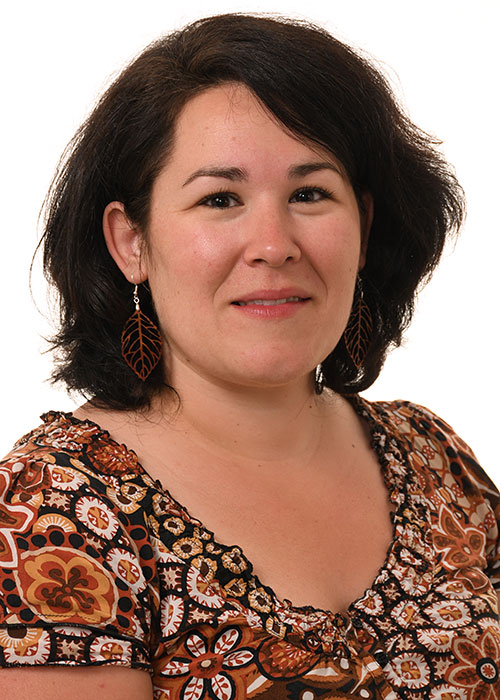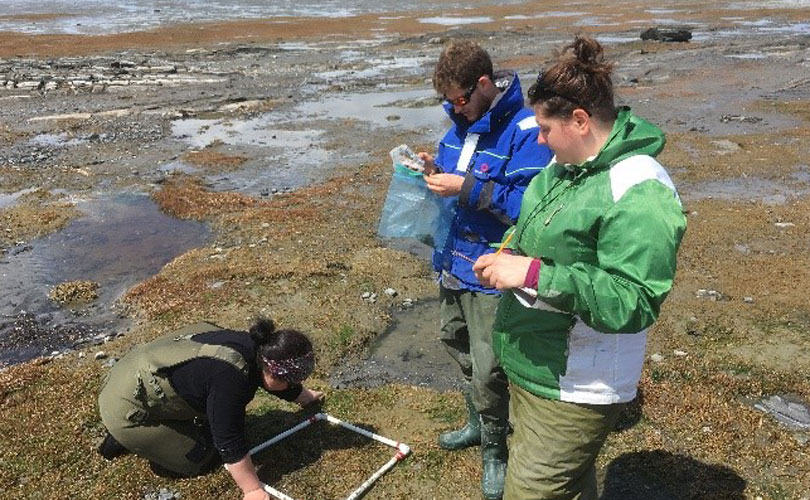
Professeure
Fanny Noisette
Départements
Institut des sciences de la mer de Rimouski
Campus
Campus de Rimouski
Courriel
Téléphone
Téléphone sans frais
Bureau
P-234
- Écologie fonctionnelle
- Écophysiologie des macroalgues et macrophytes marins
- Écogéochimie en zone côtière
- Effets des changements climatiques et globaux
- Carbone bleu
- Professeure à l’ISMER depuis 2018
- Chercheur postdoctoral Marie Curie, University of Tasmania (IMAS), Australie | GEOMAR, Allemagne, 2017-2018
- Chargée de cours, UQAR, Canada, 2017
- Chercheur postdoctoral FRQ-NT / MEOPAR, UQAR, Canada, 2016-2017
- Chercheur postdoctoral Endeavour, University of Tasmania (IMAS), Australie, 2015
- ATER, Université d’Aix Marseille, France, 2014-2015
- Doctorat en Océanographie biologique, Station Biologique de Roscoff, UPMC, France, 2010-2013
- Master en Sciences de la Mer et du Littoral, Université de Bretagne Occidentale, IUEM, France, 2008-2010
- Licence en Biologie des Organismes et des Populations, Université de Bretagne Occidentale, France, 2005-2008
Chercheures et chercheurs post-doctorant
- Elliot Dreujou (2021- 2022) Linking functional traits and community functioning in eelgrass ecosystems – Supervision : Noisette, Archambault
Étudiantes et étudiants au doctorat / PhD students
- Johanna Vega (2022- en cours) : Impacts of ocean acidification on similar calcareous primary producers between tropical and cub-artic areas – Supervision : Noisette, Villamizar (universidad del Magdalena, Colombie)
- Raphaël Mabit (2021 – en cours) : Synergie des technologies acoustique, LiDAR et hyperspectrale pour la cartographie et la classification des habitats benthiques – Surpervision : Bélanger, Noisette
- Stéphanie Roy (2020 – en cours) : Contribution des laminaires au stock de carbone bleu en zone boréale – Supervision : Noisette, Nozais, Johnson
- Ella Guscelli (2018 – en cours) : Vulnérabilité des populations de crevette nordique aux changements climatiques et globaux le long de la côte est du Canada – Supervision : Calosi, Noisette, Chabot
Étudiantes et étudiants à la maîtrise / Master students
- Olivier Hérard (2021 – en cours) : Dynamique du CO2 dans le système côtier de la Baie de Kamouraska – Supervision : Chaillou, Noisette, Mucci
- Jordan Kroeker (2020 – en cours) : Développement et validation d’un modèle bioénergétique pour la mye tronquée, M. truncata – Supervision : Deslauriers, Noisette, Mckindsey
- Marie-Pomme Poissant (2020 – en cours) : Traits fonctionnels et fonctionnement global des herbiers de zostère boréaux – Supervision : Noisette
- Clara Julliard (2019-2022) : Trajectoires d’eutrophisation de la zone côtière du Kamouraska : approches biologiques et physico-chimiques – Supervision : Noisette, Winkler, Nozais
- Romy Léger-Daigle (2019 – 2022) : Réponses photosynthétiques, physiologiques et morphologiques de la zostère (Zostera marina) sous différentes conditions lumineuses environnementales – Supervision : Nozais, Noisette, Cusson
- Lou Richer (2019 – 2022) : Allocation énergétique chez la zostère (Zostera marina) en fonction des conditions de nutriments de la côte orientale de la Baie James – Supervision : Noisette
- Mathilde Chemel (2017-2019) : Effets combinés du réchauffement, de l’acidification des océans et de l’hypoxie sur la valeur énergétique et les qualités nutritionnelle et organoleptique de la crevette nordique (Pandalus borealis) dans l’estuaire du Saint-Laurent – Supervision : Calosi, Noisette, ChabotMathilde Chemel (UQAR, 2017 – en cours) : Effets de l’augmentation de la température, de la diminution du pH et de l’hypoxie sur le métabolisme énergétique et la qualité nutritionnelle et organoleptique de la crevette nordique (Pandalus borealis) – Co-supervision Piero Calosi et Denis Chabot
- Erwann Legrand (Université de Bretagne Occidentale, 2013-2014) : Effets du pH sur les larves encapsulées de Crepidula fornicata – Co-supervion Thierry Comtet et Sophie Martin
- François Bordeyne (Université d’Aix Marseille, 2012-2013) : Impacts de l’acidification des océans sur les réponses physiologiques de l’espèce introduite Crepidula fornicata– Co-supervion Sophie Martin
Étudiantes et étudiants de premier cycle / Bachelor students
- Sophie Guibert (2023)
- Eve Tremblay-Morel (2022-2023)
- Frédérique Poulin (2022)
- Elodie Palais (DESS, été 2021)
- Aurélie Rivard (hiver 2021)
- Marie-Ève Courchesne (hiver 2020)
- Quentin Rochas (2019)
- Benoit Chambon (2019)
- Mathilde Chemel (UQAR, 2016-2017) : Quel est l’effet de la diminution du pH sur la minéralisation et la calcification – Microthèse en co-supervision avec Piero Calosi
- Sarah Piedalue (UQAR, été 2016) : Traits d’histoire de vie et physiologie des jeunes stades de vie de homard américain exposés à différents pH – Introduction à la recherche en co-supervision avec Piero Calosi
- Marie-Hélène Carignan (UQAR, 2016-2017) : Quelle est la relation entre le métabolisme et la température chez les polychaetes marins Ophryotrocha labronica ? – Microthèse en co-supervision avec Piero Calosi
Auxiliaires et professionnels de recherche
- Aurélie Rivard (automne 2021)
- Marie-Hélène Carignan (été 2021)
- Marie-Ève Chartrand Lemieux ( hiver et automne 2021)
- Marie-José Naud (2020)
- Marie-Ève Courchesne (été 2020)
(*désigne un personnel hautement qualifié supervisé)
- Roy S*, Léger Daigle R*, Mabit R*, Johnson L, Nozais C, Noisette F (2023) Nouveaux regards sur les forêts de laminaire de l’île d’Anticosti (sous presse dans le Naturaliste Canadien)
- Leblanc M-L, O’Connor M, Kuzyk Z.A, Noisette F, Davies KE, Rabbitskin E, Sam L-L, Neumeier U, Costanzo R, Ehn J, Babb D, Idrobo J, Gilbert J-P, Leblon B, Humphries M, Limited recovery following a massive seagrass decline in subarctic eastern Canada, https://doi.org/10.1111/gcb.16499
- Brodersen KE, Trevathan-Tackett S, Noisette F, Björk M, Larkum ADW, Holmer M, Kühl M (2022) Editorial: Ecophysiology and Biogeochemistry of Marine Plants in the Anthropocene, Frontiers in Marine Sciences, 9:1010651
- Massamba N’Siala G, Carignan M-H*, Calosi P, Noisette F (2022) Metabolic rate thermal plasticity in the marine annelid Ophryotrocha labronica across two successive generations, Journal of the Marine Association of the United Kingdom, 102(1-2), 69-75.
- Noisette F, Pansch C, Wall M, Wahl M, Hurd C (2022) Role of hydrodynamics in shaping chemical habitats and modulating the responses of coastal benthic systems to ocean global change, Global Change Biology, 28, 3812– 3829. https://doi.org/10.1111/gcb.16165
- Léger-Daigle R*, Noisette F, Bélanger S, Cusson M, Nozais CH (2022) Photoacclimation and light thresholds for cold temperate seagrasses, Frontiers in Plant Science, special issue Ecophysiology and Biogeochemistry of Marine Plants in the Anthropocene, 13, 805065-805065.
- Britton D, Mundy C, Noisette F, McGraw C, Hurd C (2021) Crustose coralline algae display sensitivity to near future global ocean change scenarios, ICES Journal of Marine Science, in press
- Noisette F, Calosi P, Madeira D, Chemel M*, Menu-Courey K, Piedalue S, Gurney-Smith H, Daoud D, Azetsu-Scott K (2021), Tolerant larvae and sensitive juveniles: integrating metabolomics and whole-organism responses to define life-stage specific sensitivity to ocean acidification in the American lobster, Metabolites, special issue Ectotherms Metabolism: Plasticity and Adaptation, 11(9): 584
- Noisette F, Depetris A, Hurd C, Kühl M, Brodersen, KE (2020) Flow and epiphyte growth effects on the thermal, optical and chemical microenvironment in the leaf phyllosphere of seagrass (Zostera marina), J R S Interface, 17(171), 20200485
- Guy-Haim T, Silverman J, Wahl M, Aguirre J, Noisette F, Rilov G, (2020) Epiphytes provide micro-scale refuge from ocean acidification, Marine Environmental Research, 161: 105093
- Chemel M*, Noisette F, Chabot D, Guscelli E*, Leclerc L, Calosi P (2020) Good News — Bad News: combined ocean change drivers decrease survival but have no negative impact on nutritional value and organoleptic quality of the Northern shrimp, Frontiers in Marine Science, 7: 611
- Androuin T, Six C, Bordeyne F, de Bettignies F, Noisette F, Davoult D (2020) Better off alone: new insights in the association between the flatworm Symsagittifera roscoffensis and the microalgae Tetraselmis convolutae Symbiosis, 81:161-171
- Britton D, Schmid M, Noisette F, Havenhand JN, Paine ER, McGraw CM, Revill AT, Virtue P, Nichols PD, Mundy CN, Hurd CL. (2020) Adjustments in fatty acid composition is a mechanism that can explain resilience to marine heatwaves and future ocean conditions in the habitat-forming seaweed Phyllospora comosa (Labillardière) C.Agardh. Global Change Biology 26(6), 3512-3524.
- Thibault C, Massamba-N’Siala G, Noisette F, Vermandele F, Babin M, Calosi P (2020) Within- and trans-generational responses to combined global changes are highly divergent in two congeneric species of marine annelids. Marine Biology, 167(4), 1-17, https://doi.org/10.1007/s00227-019-3644-8
- Tanoue H, Aoyama T, Komatsu T, Ruitton S., Porsmoguer SB, Noisette F, Mohri M, Suzuki I, Miyazaki N (2019) Measuring burst movements of smallmouth bass (Micropterus dolomieu) in Lake Kizaki, Japan, using micro-acceleration data loggers. La mer 57: 51-56
- Menu-Courey K, Noisette F, Piedalue S, Daoud D, Blair T, Blier P, Azetsu-Scott K, Calosi P (2019) Energy metabolism and survival of the juvenile recruits of the American lobster (Homarus americanus) exposed to a gradient of elevated seawater pCO2, Marine Environmental Research 143: 111-123
- Noisette F and Hurd C (2018) Abiotic and biotic interactions in the diffusive boundary layer of kelp blades create a potential refugia from ocean acidification, Functional Ecology, 32(5), 1329-1342.
- Legagneux P, Casajus N, Cazelles K, Chevallier C, Chevrinais M, Guéry G, Jacquet C, Jaffré M, Naud M-J, Noisette F, Ropars P, Vissault S, Archambault P, Bêty J, Berteaux D, Gravel D (2018) Our house is burning: discrepancy in climate change vs biodiversity coverage in the media as compared to scientific literature, Frontiers in Ecology and Evolution 5:175. doi: 10.3389/fevo.2017.00175
- Reidenbach LB, Fernandez PA, Leal PP, Noisette F, McGraw CM, Revill AT, Hurd CL, Kübler JE (2017) Growth, ammonium metabolism, and photosynthetic properties of Ulva australis (Chlorophyta) under decreasing pH and ammonium enrichment (Chlorophyta), PLoS ONE 12(11): e0188389.
- Davoult D, Surget G, Stiger-Pouvreau V, Noisette F, Riera P, Stagnol D, Androuin T, Poupart N (2017) Effect of Gracilaria vermiculophylla invasion on estuarine-mudflat metabolism and diversity Marine Environmental Research, 131, 227-235.
- Noisette F, Hurd C (2017). Living in the boundary layer of kelp blades: refuge from ocean acidification or training for harsh conditions? Phycologia. 56(4):137.
- Noisette F, Bordeyne F, Davoult D, Martin S (2016) Assessing the physiological responses of the gastropod Crepidula fornicata to predicted ocean acidification and warming conditions, Limnology & Oceanography 61(2): 430-444
- Noisette F, Richard J, Le Fur I, Peck L, Davoult D, Martin S (2015) Response of Crepidula fornicata metabolism to temperature stress under elevated pCO2, Journal of Molluscan Studies 81: 238-246
- Brodie J, Williamson C, Smale D, Kamenos N, Mieszkowska N, Santo R, Cunliffe M, Steinke M, Yesson C, Anderson K, Asnaghi V, Brownlee C, Burdett H, Burrows M, Collins S, Donohue P, Harvey B, Foggo A, Noisette F, Nunes J, Ragazzola F, Raven J, Schmidt D, Smith/Suggett D, Teichberg M, Hall-SpencerJ (2014) The future of the NE Atlantic benthic flora in a high CO2 world, Ecology and Evolution 4 (13): 2787-2798
- Noisette F, Comtet T, Legrand E, Bordeyne F, Davoult D, Martin S (2014) Does encapsulation protect embryos in an ocean acidification context? The example of Crepidula fornicata L. 1758, Plos One 9 (3): e93021
- Noisette F, Duong G, Six C, Davoult D, Martin S, (2013) Effects of elevated pCO2 on the metabolism of a temperate rhodolith Lithothamnion corallioides under different temperature levels, Journal of Phycology 49: 746-757
- Noisette F, Egilsdottir H, Davoult D, Martin S (2013) Physiological responses of three temperate coralline algae from contrasting habitats to near-future ocean acidification, Journal of Experimental Marine Biology and Ecology 448: 179-187
- Egilsdottir H, Noisette F, Noël L, Olafsson J, Martin S (2013) Effects of pCO2 on physiology and skeletal mineralogy in a tidal pool coralline alga Corallina elongata, Marine Biology 160 (8): 2103-2112
Premier cycle :
- BIO38818 Stage en biologie
- BIO38919 Activité de synthèse en biologie
- SCI30007 Introduction à la recherche
- SCI40007 Micro-thèse
Deuxième cycle :
- OCE61020 Océanographie générale
- OCE63016 Océanographie descriptive
- OCE74101 Plancton marin
- OCE74620 Couplages pélago-benthiques
- OCE75401 Écologie numérique
- OCE75420 Approches statistiques en océanographie
- OCE77016 Sujet spécial en océanographie
- OCE77020 Sujet spécial en océanographie
Troisième cycle :
